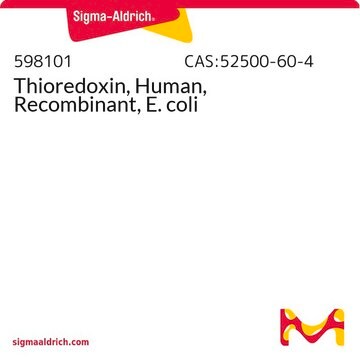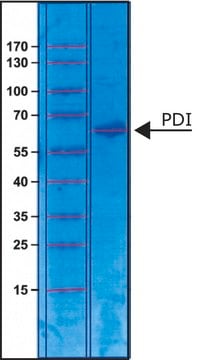T8690
Thioredoxin human
≥90% (SDS-PAGE), recombinant, expressed in E. coli (N-terminal histidine tagged), essentially salt-free, lyophilized powder, ≥5 U/mg
About This Item
Recommended Products
biological source
human
Quality Level
recombinant
expressed in E. coli (N-terminal histidine tagged)
Assay
≥90% (SDS-PAGE)
form
essentially salt-free, lyophilized powder
specific activity
≥5 U/mg
mol wt
14 kDa
technique(s)
activity assay: suitable
solubility
water: soluble 0.50—0.60 mg/mL, clear to slightly hazy, colorless to faint yellow or tan
suitability
suitable for molecular biology
UniProt accession no.
application(s)
cell analysis
storage temp.
−20°C
Gene Information
human ... TXN(7295)
General description
Application
- in mitogen-activated protein kinase kinase 4 (MKK4) in vitro kinase assay
- to study its role in transcription regulation, RNA processing and nuclear pore function in human cells
- in proteomics identification of Trx1 reduction target proteins from the hearts of cardiac specific transgenic (Tg)-Trx1 mice
Biochem/physiol Actions
Unit Definition
Legal Information
Storage Class Code
11 - Combustible Solids
WGK
WGK 3
Flash Point(F)
Not applicable
Flash Point(C)
Not applicable
Personal Protective Equipment
Certificates of Analysis (COA)
Search for Certificates of Analysis (COA) by entering the products Lot/Batch Number. Lot and Batch Numbers can be found on a product’s label following the words ‘Lot’ or ‘Batch’.
Already Own This Product?
Find documentation for the products that you have recently purchased in the Document Library.
Customers Also Viewed
Our team of scientists has experience in all areas of research including Life Science, Material Science, Chemical Synthesis, Chromatography, Analytical and many others.
Contact Technical Service










